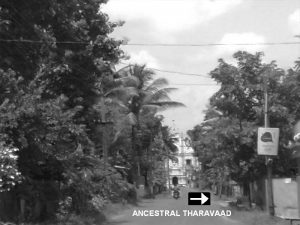The Genesis
The word Alunkal, spelled ‘aalunkal’, signifies the place by aal or banyan tree. Aal is a sacred tree associated with temples and ancient tharavads of Namboodiri families in Kerala. The tree, with its rich canopy, offers protection and solace to those who seek its ambience.
The recorded history of Alunkal Family starts from the second half of 18th century. The family hails from the port settlement at Kodungalloor in central Kerala. Kodungalloor, historically known as Mussiris, was a world famous business hub in the Malabar Coast, trading of spices, teak wood, ivory, coconut oil, etc. Mussiris was a frequented locale for both foreign and native merchants. There are several historical manuscripts linking the port with foreign traders from Rome, Constantinople, Portugal, middle-east countries, etc. Some of the latest archeological excavations bear evidence to the trade contacts of Mussiris during the Parthian period (around BC 300) in ancient Mesopotamia (Iran, Iraq), even before the arrival of Romans. Some historians, however, refer to trade contacts between West Asian countries and Malabar dating back to BC 3000). It is only natural that the Christian community, especially the Syrian Christians from Middle East came to the place, in due course. The ancestors of the Alunkal Family, who resided here, were the Syrian Christian converts from the local Kshethrias (Namboodiri), the princely caste among the natives.
It is believed that St. Thomas, the disciple of Jesus Christ, visited Malabar in 52 AD. The Apostle took the sea-route from west Asia and landed in Mussiris. The local people were attracted by the teachings and divine miracles of the Apostle and many of them got converted to Christianity. The ancestors of Alunkal family at Kodungalloor are also believed to have embraced Christianity during the time of the Apostle.
The arrival of Kana Thoma (Khnayithoma)
Notable among the Christian merchants, who visited Kodungalloor, was Kana Thoma who came with an entourage of about 400 Syrian Christians from the Middle East, in 345 AD. This large group came with a specific purpose of domicile trading on a sustained basis. There was a Syrian Episcope (Bishop), by name Joseph from the city of Jerusalem, in this group. It was the period when Cheraman Perumal, the Chera king, ruled over the area. The king welcomed the Syrian merchants and gave them all local facilities to carry out their trade. The Syrian settlers established immediate rapport with the local Christians, resulting in social and cultural mixing of the communities. Thus, Kodungalloor became a fusion point of the native and migrant Syrian Christians. For the native Christians it was a God sent opportunity to continue their historic liaison with the Apostolic Syrian Christian Church of the East.
The Exodus
The aggressive invasions by dictatorial rulers Hyder Ali and his son Tippu Sultan, from the neighboring state of Mysore, during the period AD 1766-1791, upset the life and lively-hood of the people at Mussiris. Many in the Malabar region fell pray to the invading army. People fled from their homes fearing the sword of Tippu. History reveals that those belonging to the upper class were severely affected by the invasions. There was mass exodus of local rulers, land lords and people from the higher echelons in the society fearing coercion, looting and religious conversion. Among them were members of the Alunkal family. They took the backwater route to reach Udayamperoor, an inland port and trade center 40 km south of Kodungalloor. Since Kandanad was the nearby Syrian Christian settlement, hosting the famous St. Mary’s Syrian Church, the family chose it as their permanent habitat. The family bought a small piece of land, 300 m west of the Church lane. The location was known as thazhathangadi, in local parlance meaning ‘market at the lower (western) side’, the point of reference being the Church lane. The family stayed in an L- shape house, typical of such house-cum- shop in busy market lanes. This house, named as Thazhathu formed the nucleus of the Alunkal family, in and around Kandanad.

Kandanad was a thriving trade center during that period due to the proximity of Udayamperoor port, connected by inland water ways. A sizable trading population, consisting mainly of Syrian Christians, was already settled in the area. The migrant family, therefore, had no difficulty in integrating with the local environment and people.
No details are available regarding the entourage of the first Alunkal family, which migrated from Kodungalloor and settled at Kandanad. AD 1780 is the most probable year when they reached Kandanad. The family was led by Mathai, father of Itteerah, who was born after the family established a proper foot-hold at Kandanad. Being the youngest son Itteerah inherited the parental house Thazhathu. His two elder brothers moved out to nearby houses by the side of the same Church lane. The names of those houses were typically Naduvil and Karottu. In the absence of male progenies, those houses ceased to be identified with the mainstream family, subsequently. (We consider this as extremely frustrating aspect as it has made the search on our ancestral links very difficult) We are, therefore, constrained to describe only about Itteerah and his progeny in this space. Those who read this Family History on our web site are earnestly requested to share whatever information they have on the above two branches as also any details/corrections/clarifications on the features presented here.
The following points are considered important and require answers:
-
Who were all there with the migrant family (relatives, neighbors, others?
-
The ancestral lineage of Itteerah?
-
What is the link between the Alunkal family at Kandanad and those families bearing the same surname, which include some Namboodiri families? (We contacted some members of the Alunkal Mana at Udayamperoor and came to know that some of their ancestral properties were linked to families from Kodungalloor (Mussiris). The present generation is not able to provide any further clues in this matter)
-
Did everybody in the team settle at Kandanad; if not, where did others go?
